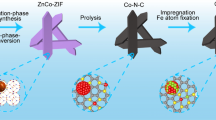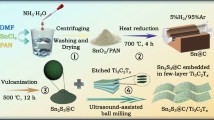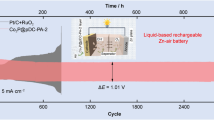Abstract
Seawater electrolysis technology powered by clean new energy is recognized as the most promising sustainable and green hydrogen preparation method. The extremely expensive and low reserve of commercially available noble metal electrocatalysts and the rapid inactivation of catalysts under complex ionic environments hamper their industrialization. Herein, a novel interwoven N-doped carbon nanotube (N-CNTs) structure capped with Ni-doped FeP nanoparticles (NFP@NC) is successfully developed by Ni-doped Fe cluster-catalyzed CNT growth process and the gas phosphating method. The unique interwoven nanotube network and strong interaction of Ni-doped FeP and N-CNTs provide fast mass transfer and gas bubble emission, as well as drastically enhanced stability. The NFP@NC presents an overpotential of 280 mV for the oxygen evolution reaction and 206 mV for the hydrogen evolution reaction at 10 mA cm−2, lower than most reported iron-based catalysts. This research provides an effective way to construct interwoven CNT networks as high-performance bifunctional seawater electrolysis catalysts.

摘要
清洁能源支撑的电解海水技术是公认的最有前途的未来可持续 绿色制氢途径. 商用贵金属催化剂储量低、成本昂贵, 且在复杂离子环 境下容易快速失活的特性, 严重阻碍了电解海水技术的工业化发展. 本 工作通过Ni掺杂Fe团簇催化碳纳米管生长, 再气体磷化法, 成功构建了 一种含Ni 掺杂FeP 纳米颗粒封端的新型氮掺杂碳纳米管交织结构 (NFP@NC). 独特的N-CNTs交织网络, 以及N-CNTs和Ni掺杂FeP的** 相互作用提供了快速的传质途径, 提高了气体逸出效率, 并显著增**了 催化剂稳定性. NFP@NC在10 mA cm−2 的电流密度下的析氧反应过电 位为280 mV, 析氢反应过电位为206 mV, 低于大多数报道的铁基催化 剂. 本研究为构建交织的碳纳米管网络和制备高性能双功能海水电解 催化剂提供了一种有效的途径.
Similar content being viewed by others
References
Zhang Q, Bai H, Zhang Q, et al. MoS2 yolk-shell microspheres with a hierarchical porous structure for efficient hydrogen evolution. Nano Res, 2016, 9: 3038–3047
Wei M, Li J, Chu W, et al. Phase control of 2D binary hydroxides nanosheets via controlling-release strategy for enhanced oxygen evolution reaction and supercapacitor performances. J Energy Chem, 2019, 38: 26–33
Su H, Soldatov MA, Roldugin V, et al. Platinum single-atom catalyst with self-adjustable valence state for large-current-density acidic water oxidation. eScience, 2022, 2: 102–109
Zeng Y, Chen L, Chen R, et al. One-step, room temperature generation of porous and amorphous cobalt hydroxysulfides from layered double hydroxides for superior oxygen evolution reactions. J Mater Chem A, 2018, 6: 24311–24316
** Z, Zhang Y, Ma Q. Orthorhombic WP co-catalyst coupled with electron transfer bridge UiO-66 for efficient visible-light-driven H2 evolution. J Colloid Interface Sci, 2019, 556: 689–703
**e J, Qi J, Lei F, et al. Modulation of electronic structures in two-dimensional electrocatalysts for the hydrogen evolution reaction. Chem Commun, 2020, 56: 11910–11930
Liu T, Diao P. Nickel foam supported Cr-doped NiCo2O4/FeOOH nanoneedle arrays as a high-performance bifunctional electrocatalyst for overall water splitting. Nano Res, 2020, 13: 3299–3309
Ma P, Luo S, Luo Y, et al. Vertically aligned FeOOH nanosheet arrays on alkali-treated nickel foam as highly efficient electrocatalyst for oxygen evolution reaction. J Colloid Interface Sci, 2020, 574: 241–250
Zhang S, Gao G, Zhu H, et al. In situ interfacial engineering of nickel tungsten carbide Janus structures for highly efficient overall water splitting. Sci Bull, 2020, 65: 640–650
Li Y, Wang H, Priest C, et al. Advanced electrocatalysis for energy and environmental sustainability via water and nitrogen reactions. Adv Mater, 2021, 33: e2000381
Hao J, Zhuang Z, Cao K, et al. Unraveling the electronegativity-dominated intermediate adsorption on high-entropy alloy electrocatalysts. Nat Commun, 2022, 13: 2662
Wu Z, Gao Y, Wang Z, et al. Surface-enriched ultrafine Pt nanoparticles coupled with defective CoP as efficient trifunctional electrocatalyst for overall water splitting and flexible Zn-air battery. Chin J Catal, 2023, 46: 36–47
Yang Y, Su J, Jiang P, et al. MOFs-derived N-doped carbon-encapsulated metal/alloy electrocatalysts to tune the electronic structure and reactivity of carbon active sites. Chin J Chem, 2021, 39: 2626–2637
Yuan F, Liu Y, Ma P, et al. Coupling interface structure in NixS/Cu5FeS4 hybrid with enhanced electrocatalytic activity for alkaline hydrogen evolution reaction. J Colloid Interface Sci, 2020, 578: 668–676
Zang W, Sun T, Yang T, et al. Efficient hydrogen evolution of oxidized Ni-N3 defective sites for alkaline freshwater and seawater electrolysis. Adv Mater, 2021, 33: e2003846
Zhang L, Wang Z, Qiu J. Energy-saving hydrogen production by sea-water electrolysis coupling sulfion degradation. Adv Mater, 2022, 34: 2109321
Zheng W, Lee LYS, Wong KY. Improving the performance stability of direct seawater electrolysis: From catalyst design to electrode engineering. Nanoscale, 2021, 13: 15177–15187
Chen Z, Li Q, **ang H, et al. Hierarchical porous NiFe-P@NC as an efficient electrocatalyst for alkaline hydrogen production and seawater electrolysis at high current density. Inorg Chem Front, 2023, 10: 1493–1500
Zhu H, Sun S, Hao J, et al. A high-entropy atomic environment converts inactive to active sites for electrocatalysis. Energy Environ Sci, 2023, 16: 619–628
Wen Q, Zhao Y, Liu Y, et al. Ultrahigh-current-density and long-term-durability electrocatalysts for water splitting. Small, 2022, 18: e2104513
Huang Y, Hu L, Liu R, et al. Nitrogen treatment generates tunable nanohybridization of Ni5P4 nanosheets with nickel hydr(oxy)oxides for efficient hydrogen production in alkaline, seawater and acidic media. Appl Catal B-Environ, 2019, 251: 181–194
Lu Y, Zhang H, Wang Y, et al. Solar-driven interfacial evaporation accelerated electrocatalytic water splitting on 2D perovskite oxide/MXene heterostructure. Adv Funct Mater, 2023, 33: 2215061
Lu XF, Yu L, Lou XWD. Highly crystalline Ni-doped FeP/carbon hollow nanorods as all-pH efficient and durable hydrogen evolving electrocatalysts. Sci Adv, 2019, 5: eaav6009
Sun Y, Gao S, Lei F, et al. Atomically-thin two-dimensional sheets for understanding active sites in catalysis. Chem Soc Rev, 2015, 44: 623–636
Shi J, Qiu F, Yuan W, et al. Novel electrocatalyst of nanoporous FeP cubes prepared by fast electrodeposition coupling with acid-etching for efficient hydrogen evolution. Electrochim Acta, 2020, 329: 135185
Li T, Wang J, Wang F, et al. The effect of surface wettability and coalescence dynamics in catalytic performance and catalyst preparation: A review. ChemCatChem, 2019, 11: 1576–1586
Hu K, Blair AD, Piechota EJ, et al. Kinetic pathway for interfacial electron transfer from a semiconductor to a molecule. Nat Chem, 2016, 8: 853–859
Wu HB, **a BY, Yu L, et al. Porous molybdenum carbide nano-octahedrons synthesized via confined carburization in metal-organic frameworks for efficient hydrogen production. Nat Commun, 2015, 6: 6512
Wang P, Yu Q, Long Y, et al. Multivalent assembly of ultrasmall nanoparticles: One-, two-, and three-dimensional architectures of 2 nm gold nanoparticles. Nano Res, 2012, 5: 283–291
Zhu Z, Hao J, Zhu H, et al. In situ fabrication of electrospun carbon nanofibers-binary metal sulfides as freestanding electrode for electrocatalytic water splitting. Adv Fiber Mater, 2021, 3: 117–127
Wang C, Li W, Wang X, et al. Open N-doped carbon coated porous molybdenum phosphide nanorods for synergistic catalytic hydrogen evolution reaction. Nano Res, 2022, 15: 1824–1830
Wu Z, Yang P, Li Q, et al. Microwave synthesis of Pt clusters on black TiO2 with abundant oxygen vacancies for efficient acidic electrocatalytic hydrogen evolution. Angew Chem Int Ed, 2023, 62: e202300406
**ong T, Li J, Chandra Roy J, et al. Hetero-interfacial nickel nitride/vanadium oxynitride porous nanosheets as trifunctional electrodes for HER, OER and sodium ion batteries. J Energy Chem, 2023, 81: 71–81
Zhao Z, Long Y, Luo S, et al. Metal-free C3N4 with plentiful nitrogen vacancy and increased specific surface area for electrocatalytic nitrogen reduction. J Energy Chem, 2021, 60: 546–555
Wang J, Tang J, Ding B, et al. Self-template-directed metal-organic frameworks network and the derived honeycomb-like carbon flakes via confinement pyrolysis. Small, 2018, 14: e1704461
Pei X, Chen Y, Li S, et al. Metal-organic frameworks derived porous carbons: Syntheses, porosity and gas sorption properties. Chin J Chem, 2016, 34: 157–174
Wang C, Chen Y, Zhong M, et al. Hollow mesoporous carbon nanocages with Fe isolated single atomic site derived from a MOF/polymer for highly efficient electrocatalytic oxygen reduction. J Mater Chem A, 2021, 9: 22095–22101
**ong T, Yao X, Zhu Z, et al. In situ grown Co-based interstitial compounds: Non-3d metal and non-metal dual modulation boosts alkaline and acidic hydrogen electrocatalysis. Small, 2022, 18: 2105331
Chen M, Hu Y, Liang K, et al. Interface engineering triggered by carbon nanotube-supported multiple sulfides for boosting oxygen evolution. Nanoscale, 2021, 13: 18763–18772
Zhou G, Liu G, Liu X, et al. 1D/3D heterogeneous assembling body as trifunctional electrocatalysts enabling zinc-air battery and self-powered overall water splitting. Adv Funct Mater, 2022, 32: 2107608
Wang X, Dong A, Hu Y, et al. A review of recent work on using metal-organic frameworks to grow carbon nanotubes. Chem Commun, 2020, 56: 10809–10823
Chen Z, Kim DY, Hasegawa K, et al. Methane-assisted chemical vapor deposition yielding millimeter-tall single-wall carbon nanotubes of smaller diameter. ACS Nano, 2013, 7: 6719–6728
Zhao X, Li F, Wang R, et al. Controlled fabrication of hierarchically structured nitrogen-doped carbon nanotubes as a highly active bifunctional oxygen electrocatalyst. Adv Funct Mater, 2017, 27: 1605717
Wang S, Qin J, Meng T, et al. Metal-organic framework-induced construction of actiniae-like carbon nanotube assembly as advanced multifunctional electrocatalysts for overall water splitting and Zn-air batteries. Nano Energy, 2017, 39: 626–638
Hu L, Hu Y, Liu R, et al. Co-based MOF-derived Co/CoN/Co2P ternary composite embedded in N- and P-doped carbon as bifunctional nanocatalysts for efficient overall water splitting. Int J Hydrogen Energy, 2019, 44: 11402–11410
Zhu H, Zhu Z, Hao J, et al. High-entropy alloy stabilized active Ir for highly efficient acidic oxygen evolution. Chem Eng J, 2022, 431: 133251
Li S, Cheng C, Liang HW, et al. 2D porous carbons prepared from layered organic-inorganic hybrids and their use as oxygen-reduction electrocatalysts. Adv Mater, 2017, 29: 1700707
Gournis D, Karakassides MA, Bakas T, et al. Catalytic synthesis of carbon nanotubes on clay minerals. Carbon, 2002, 40: 2641–2646
Liu Y, Jiang H, Zhu Y, et al. Transition metals (Fe, Co, and Ni) encapsulated in nitrogen-doped carbon nanotubes as bi-functional catalysts for oxygen electrode reactions. J Mater Chem A, 2016, 4: 1694–1701
Zhang R, He S, Lu Y, et al. Fe, Co, N-functionalized carbon nanotubes in situ grown on 3D porous N-doped carbon foams as a noble metalfree catalyst for oxygen reduction. J Mater Chem A, 2015, 3: 3559–3567
Yu Q, Liu X, Liu G, et al. Constructing three-phase heterojunction with 1D/3D hierarchical structure as efficient trifunctional electrocatalyst in alkaline seawater. Adv Funct Mater, 2022, 32: 2205767
Zhao X, Pachfule P, Li S, et al. Bifunctional electrocatalysts for overall water splitting from an iron/nickel-based bimetallic metal-organic framework/dicyandiamide composite. Angew Chem Int Ed, 2018, 57: 8921–8926
Guo Y, Yuan P, Zhang J, et al. Co2P-CoN double active centers confined in N-doped carbon nanotube: Heterostructural engineering for trifunctional catalysis toward HER, ORR, OER, and Zn-air batteries driven water splitting. Adv Funct Mater, 2018, 28: 1805641
Fan M, Cui J, Wu J, et al. Improving the catalytic activity of carbon-supported single atom catalysts by polynary metal or heteroatom do**. Small, 2020, 16: 1906782
Chen Z, Zhang S, Zhao J, et al. Iodine-induced formation of C-pyridinic-N-Co sites on carbon-encapsulated cobalt nanocrystals as electrocatalyst for rechargeable Zn-air batteries. Chem Eng J, 2023, 462: 142030
Sonoda Y. Chain-length-dependent photophysical properties of α,ω-di(4-pyridyl)polyenes: Effects of solvent polarity, hydrogen bond formation, protonation, and N-alkylation. J Fluoresc, 2022, 32: 95–108
Yan Y, Yan S, Yu Z, et al. Low-work-function silver activating N-doped graphene as efficient oxygen reduction catalysts in acidic medium. ChemCatChem, 2019, 11: 1033–1038
Wang P, Zheng Y, Li B. Preparation and electrochemical properties of polypyrrole/graphite oxide composites with various feed ratios of pyrrole to graphite oxide. Synth Met, 2013, 166: 33–39
Zhu R, Zhu Y, **an H, et al. CNTs/ferrihydrite as a highly efficient heterogeneous Fenton catalyst for the degradation of bisphenol A: The important role of CNTs in accelerating Fe(III)/Fe(II) cycling. Appl Catal B-Environ, 2020, 270: 118891
Yan Y, Zhao B, Yi SC, et al. Assembling pore-rich FeP nanorods on the CNT backbone as an advanced electrocatalyst for oxygen evolution. J Mater Chem A, 2016, 4: 13005–13010
Zhang J, Kong Q, Wang DY. Simultaneously improving the fire safety and mechanical properties of epoxy resin with Fe-CNTs via large-scale preparation. J Mater Chem A, 2018, 6: 6376–6386
Biesinger MC, Payne BP, Grosvenor AP, et al. Resolving surface chemical states in XPS analysis of first row transition metals, oxides and hydroxides: Cr, Mn, Fe, Co and Ni. Appl Surf Sci, 2011, 257: 2717–2730
Yaqoob L, Noor T, Iqbal N, et al. Electrochemical synergies of Fe-Ni bimetallic MOF CNTs catalyst for OER in water splitting. J Alloys Compd, 2021, 850: 156583
Choi Y, Kim D, Lin L, et al. CuFeN/CNT composite derived from kinetically modulated urchin-shaped MOF for highly efficient OER catalysis. Electrochim Acta, 2021, 389: 138637
Hou W, Wang S, Li Y, et al. Influence of modified biochar supported Fe-Cu/polyvinylpyrrolidone on nitrate removal and high selectivity towards nitrogen in constructed wetlands. Environ Pollution, 2021, 289: 117812
Von Lim Y, Huang S, Zhang Y, et al. Bifunctional porous iron phosphide/carbon nanostructure enabled high-performance sodium-ion battery and hydrogen evolution reaction. Energy Storage Mater, 2018, 15: 98–107
Wang B, Hu Y, Yu B, et al. Heterogeneous CoFe-Co8FeS8 nanoparticles embedded in CNT networks as highly efficient and stable electro-catalysts for oxygen evolution reaction. J Power Sources, 2019, 433: 126688
Yu J, Zhang T, Sun Y, et al. Hollow FeP/Fe3O4 hybrid nanoparticles on carbon nanotubes as efficient electrocatalysts for the oxygen evolution reaction. ACS Appl Mater Interfaces, 2020, 12: 12783–12792
Zhang Y, Jiang H, Lin Y, et al. In situ growth of cobalt nanoparticles encapsulated nitrogen-doped carbon nanotubes among Ti3C2T, (MXene) matrix for oxygen reduction and evolution. Adv Mater Inter, 2018, 5: 1800392
**a Q, Liu H, ** M, et al. Catalysts confined inside CNTs derived from 2D metal-organic frameworks for electrolysis. Nanoscale, 2020, 12: 8969–8974
Yu D, Ilango PR, Han S, et al. Metal-organic framework derived Co@NC/CNT hybrid as a multifunctional electrocatalyst for hydrogen and oxygen evolution reaction and oxygen reduction reaction. Int J Hydrogen Energy, 2019, 44: 32054–32065
Li JS, Du B, Lu ZH, et al. In situ-generated Co@nitrogen-doped carbon nanotubes derived from MOFs for efficient hydrogen evolution under both alkaline and acidic conditions. New J Chem, 2017, 41: 10966–10971
Chao S, Liu P, **a Q, et al. Facile construction of N-doped carbon nanotubes encapsulating Co nanoparticles as a highly efficient multifunctional catalyst for electrochemical reactions. CrystEngComm, 2021, 23: 1671–1676
Liu Z, Dong CL, Huang YC, et al. Modulating the electronic structure of ultrathin layered double hydroxide nanosheets with fluorine: An efficient electrocatalyst for the oxygen evolution reaction. J Mater Chem A, 2019, 7: 14483–14488
Li Y, Wu Y, Hao H, et al. In situ unraveling surface reconstruction of Ni5P4@FeP nanosheet array for superior alkaline oxygen evolution reaction. Appl Catal B-Environ, 2022, 305: 121033
Feng Y, Xu C, Hu E, et al. Construction of hierarchical FeP/Ni2P hollow nanospindles for efficient oxygen evolution. J Mater Chem A, 2018, 6: 14103–14111
Zhao X, Zhang Z, Cao X, et al. Elucidating the sources of activity and stability of FeP electrocatalyst for hydrogen evolution reactions in acidic and alkaline media. Appl Catal B-Environ, 2020, 260: 118156
Xu S, Zhao H, Li T, et al. Iron-based phosphides as electrocatalysts for the hydrogen evolution reaction: Recent advances and future prospects. J Mater Chem A, 2020, 8: 19729–19745
Acknowledgements
This work was supported by the National Natural Science Foundation of China (52272222 and 52072197), the Outstanding Youth Foundation of Shandong Province, China (ZR2019JQ14), the Youth Innovation and Technology Foundation of Shandong Higher Education Institutions, China (2019KJC004), the Natural Science Foundation of Shandong Province, China (ZR2021MB061), the Major Scientific and Technological Innovation Project (2019JZZY020405), Taishan Scholar Young Talent Program (tsqn201909114), and the Major Basic Research Program of Natural Science Foundation of Shandong Province (ZR2020ZD09).
Author information
Authors and Affiliations
Contributions
Author contributions Zhang H and Wang Y conducted the experiments, analyzed the data, and prepared the manuscript. Zhang B, Zhang S, Ma Y, and Wu Z analyzed and discussed the data. Zhu Y and Liu F commented on the manuscript. **ao Z revised the paper and directed the entire research. Wang L conducted the writing and editing. The project was supervised by Wang L and **ao Z. All authors contributed to the general discussion.
Corresponding authors
Ethics declarations
Conflict of interest The authors declare that they have no conflict of interest.
Additional information
Supplementary information Experimental details and supporting data are available in the online version of the paper.
Han Zhang is currently a Master’s candidate at Qingdao University of Science and Technology. She received her BS degree from Qingdao University of Science and Technology (2021). Her research focuses on the design and synthesis of MOF-derived materials in electrocatalysis.
Yonglong Wang is currently a Master candidate at Qingdao University of Science and Technology. He received his BS degree from Liaocheng University (2020). His research interests focus on the design and synthesis of MOF-derived materials for seawater splitting.
Zhenyu **ao was awarded a PhD degree by China University of Petroleum (East China) in 2017 under the supervision of Prof. Daofeng Sun. He is currently an associate professor at Qingdao University of Science and Technology. His research interests mainly focus on MOF materials, nanomaterials, supercapacitors, and electrocatalysis.
Lei Wang was awarded a PhD degree in chemistry by Jilin University in 2006 under the supervision of Prof. Shouhua Feng. He moved to the State Key Laboratory of Crystal Materials, Shandong University, as a postdoctoral scholar from 2008 to 2010. He is currently a professor of chemistry at Qingdao University of Science and Technology. His research interests mainly focus on the design and synthesis of functional organic-inorganic hybrids and porous MOF materials, as well as their applications in photocatalysis, electrocatalysis, lithium-ion batteries, etc.
Electronic supplementary material
40843_2023_2608_MOESM1_ESM.pdf
Interwoven N-doped carbon nanotubes with capped Ni-doped FeP as double-functional electrocatalysts for overall seawater electrolysis
Rights and permissions
About this article
Cite this article
Zhang, H., Wang, Y., Zhang, B. et al. Interwoven N-doped carbon nanotubes with capped Ni-doped FeP as double-functional electrocatalysts for overall seawater electrolysis. Sci. China Mater. 66, 4630–4638 (2023). https://doi.org/10.1007/s40843-023-2608-6
Received:
Accepted:
Published:
Issue Date:
DOI: https://doi.org/10.1007/s40843-023-2608-6




